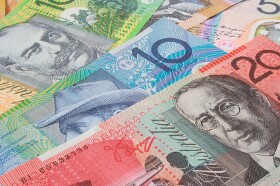
The Australian dollar has experienced strong volatile moves lately. The currency tanked in the first half of March, recovered a bit in the second half only to move down again in April. While it is hard to predict price movements during such volatile time, let’s see what factors will be affecting the Aussie this week and how the currency can react to them.
The week will start with somewhat less important economic reports: the Melbourne Institute inflation gauge and ANZ job advertisements, followed by the services index from the Australian Industry Group released overnight. While the reports usually have a limited impact on markets, this time can be different as they will be among the first reports for March, allowing traders to see how the Australian economy reacted to the global COVID-19 pandemic.
Tuesday will different as the Reserve Bank of Australia will conduct a monetary policy meeting. While the consensus forecast is that the RBA will keep the main interest rate unchanged at 0.25% following two cuts in March, some analysts predict another cut, which would lower the rate to zero percent. If the pessimistic outlook proves to be true, the Aussie will likely try to retest March lows.
Also on Tuesday, the Australian Bureau of Statistics will release trade balance data. Experts have predicted ahead of the report that it will show a decrease of the trade surplus from A$5.21 billion to A$3.75 billion. It is important to remember that the report will show results for February, meaning that the data is delayed and can be considered outdated in the current volatile environment.
The RBA will release the semi-annual Financial Stability Review on Wednesday. Market participants watch the report, hoping to glimpse plans the central bank has for monetary policy. The rest of the week will be empty in terms of macroeconomic releases, and Australian markets (as well as markets in many other countries) will be closed on Friday due to the Good Friday holiday.
One possible silver lining for the Australian dollar and other commodity-related currencies was the planned meeting between the OPEC members, Russia, and several other oil-producing countries on Monday. Market participants were hoping that Saudi Arabia, the de facto leader of the OPEC, and Russia would find a compromise, ending the price war and signing a new deal to reduce oil production, which would help to buoy prices for the commodity. Indeed, DailyFX said in its forecast for the Australian dollar:
There remains some hope that the oil price war between Russia and Saudi Arabia might end, perhaps quite soon. That might well give the entire commodity complex a boost, well beyond the energy market, maybe lifting the commodity-linked Australian Dollar too.
But the latest news suggests that the meeting is delayed due to the conflict between Russia and Saudi Arabia as the countries were blaming each other for the collapse of the production cut deal and the subsequent slump of oil prices.
Considering all the factors, it is hard to expect anything but a decline from the Australian currency. As of the time of writing, AUD/USD traded around the psychologically important level of 0.6000. In case of a downward move, the 0.5730 can provide support as it did in March. The previous bounce stopped at about 0.6170, and it can be a major resistance level in case the currency tries to move up.
As for analysts’ forecasts, Forex Crunch was bearish on the Aussie, saying:
As a risk currency, the Aussie has been struggling, as the CORVID-19 crisis has sapped risk apprehension. The outlook remains bearish for the currency.
DailyFX was also bearish, predicting an interest rate cut from the RBA:
It is probably more likely than not that rates in Australia will fall again this week. Itâs hard to see the Australian Dollar recovering should this be the case, especially if the market becomes convinced as it surely will that matters need not necessarily rest with zero interest rates and that some Quantitative Easing could follow.
If you have any questions, comments, or opinions regarding the Australian Dollar, feel free to post them using the commentary form below.